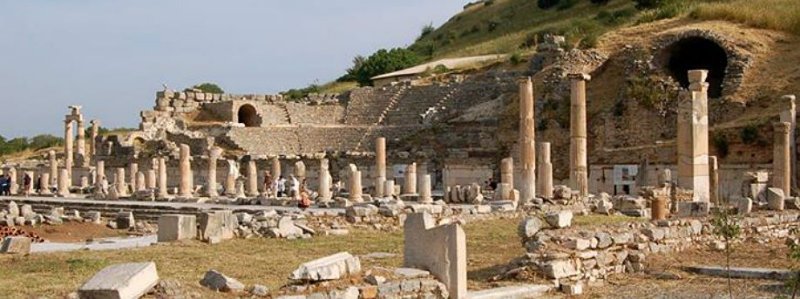Temple of Serapis in Ephesus
The Serapion district is the best-preserved Temple Complex on the outskirts of Bulbul Mountain in Ephesus. Despite many years of work, it is not possible to make a full interpretation of the temple and hollyle walls (Temenos). A new comprehensive Project will carry out a study on the temple area and its importance in the history of Ephesus.
The Serapion Area consists of a Roman Temple with a Podium and a Temenos wall of 100 x 75 m and is located on the northern skirts of Bulbul Mountain and to the west of the Agora.
The temple, built in the 2nd century AD, is one of the best preserved buildings in Ephesus.
The view of the giant columns and the roof attracted the attention of those who visited here in the 18th and 19th centuries, and it was thought to be a temple built for Emperor Claudius.
In the first excavations of 1911 and 1913, it was understood that the temple was not only made of huge Monobloc building elements but also water had a special importance for this temple. Because water was shipped with a special line to the temple room. Of course, the presence of the water line in the first place could have thought that there was a fountain structure.
Since the archaeologists found some inscriptions about the religion of Egypt in 1926, they suggested that this place could be the Temple of Serapis. Although the excavations in 1990 and 1992 suggest that it does not belong to Serapis, it is still called the Serapis Temple area, although there are question marks about its dating, devotion and purpose of use have still not been solved. Within the scope of the new project, a team will examine the front face of the temple in detail. Another team is working on the decorations and epigraphic inscriptions. There are also works for ceramics and coins found in this temple area in Ephesus. Conservation of walls and walls is also maintained.
The temple is located in the back of Temenos. The podium can be reached by flashy stairs. The large 8 columns at the entrance had Corinthian titles. The temple's double walls created a corridor between the temple room and the outside walls. The narrow staircase behind the temple was reaching to upper floors, which are not available at the moment.
The temple room is located on the south of the apse with dimensions of 17x20 m. There are 6 niches on the side walls of 1.5 m in height and one niche on the sides of the apse.
The niches probably had water ponds, because the drain pipes still exist. There were niches on the side walls, and they came down to the ground, but there were no water ponds.
During the early Christian period, the temple was converted into a church and the building elements related to it were prominent in the temple room.

